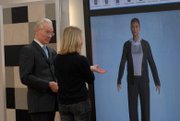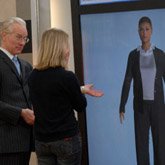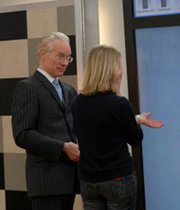3-D Technology Expanding Well Beyond the Design Studio
Once upon a time, 3-D technology was the domain of Hollywood special-effects technicians and video-game producers. Then CAD companies began incorporating it into pattern-making to help pattern designers visualize finished garments and thus reduce the many iterations required to produce a sample. Now 3-D is expanding beyond the patternmaker’s studio for use in other visual applications.
On the Bravo TV program “Tim Gunn’s Guide to Style,” a show in which the “Project Runway” mentor helps ordinary women reinvent themselves through fashion, one of the key tools in achieving that goal is through 3-D software provided by New York–based Optitex USA.
Optitex supplies dozens of apparel manufacturers and retailers with its 3-D Runway Designer software, which allows users to drape virtual garments over a 3-D avatar, or mannequin, to provide a visual representation of the finished product. Gunn, formerly with the Parsons School of Design and currently with Liz Claiborne, was intrigued with the capabilities of the software and incorporated it into the Parsons curriculum and on his style show as a way of helping his makeover subjects visualize their bodies in an objective manner.
“Optitex sees your shape in a completely new way,” explained the show’s executive producer, Sarah-Jane Cohen. “It was Tim’s idea to use it. We were discussing how to allow the women to see their bodies without the use of a mirror because when they look in a mirror, most of the time, they go directly to the parts of their bodies they are not happy with. Tim is good at explaining how the use of the software can provide balance. Tim will use it on the spot and ’sketch’ looks that deal with concerns such as large chests or elongated necks and virtually dress the subject with a mid-calf skirt to make them look shorter or whatever the situation. Eventually, we deal with every body type.”
Optitex President Yoram Burg said he is sometimes amazed at where users of the company’s software take it.
“The way Tim uses the 3-D technology is very exciting,” he said. “When companies started using this technology, it was initially meant for internal production, fit sessions and the like. While this is still the idea, more and more companies are taking it to other directions such as internal visualization sessions, Web solutions and more. So it is very exciting—and represents the trend that has started since the economic downturn— more and more companies are getting off the fence and are looking to deploy quick and affordable ROI solutions—[it’s] a must these days.”
Burg said since the show debuted last year, the company has received hundreds of e-mails and other correspondences from consumers who have been struggling with how to buy garments that fit them.
“We get many responses that say this show has changed their lives,” he said. “It is exciting to see how one image can help a lost person find their perfect look and fit. Tim does an excellent job in conveying a message that there is a very advanced technology behind the clothes we wear.”
Optitex recently offered a version of its 3-D software to consumers via the home sewing market. It has partnered with Swiss sewing company Bernina (www.berninamylabel.com) to enable consumers to create a garment and drape it over a 3-D mannequin built using their own body measurements. Customers such as St. Louis–based swimwear designer Lori Coulter are involving 3-D body scanners to take digital measurements of consumers, which can be exported into the Optitex software to create a near-perfect customized swimsuit. The body scanner is located at a nearby Macy’s.
Optitex and rival Tukatech, based in Los Angeles, have also added motion simulation to see how garments react to movement. In some cases, Tukatech customers can create virtual samples in one shot without ever having to create the usual eight to 10 samples per garment. Other customers are even importing the 3-D representations into their Apple iPhones.
Cary, N.C.–based TC2 is also at the forefront of 3-D technology. The company is known for its body scanners, which record digital body measurements to be used for made-tomeasure systems, dress forms, patternmaking and other applications.
More recently, it has developed an application that creates high-resolution personal avatars in only a few seconds. They can be exported into Second Life and have other uses.
TC2 President Mike Fralix sees enormous potential for such tools.
“You can create these for consumer feedback and focus groups and for marketing and sales. If you get the feedback that far in advance, you can save lots of time and money,” he explained.
TC2 also is seeing its technology being used in the medical field in the area of predictive analysis.
“In plastic-surgery applications, it helps obese patients visualize what they will look like after surgery. It also helps surgeons determine what areas to cut first.”
TC2’s body scanners have gradually become smaller in size and price. The company is working on a new model that is expected to cost about $25,000, making it affordable for smaller companies. It currently is priced around $40,000 and is about 4 feet by 4 feet.
Even Big Blue is jumping on the 3-D bandwagon. IBM recently announced it is aligning with the New York–based Fashion Research Institute (FRI) to implement the first product lifecycle management (PLM) system in a virtual setting, namely in the simulated world of Second Life (www.secondlife.com), a domain where American Apparel and others have taken up residence.
FRI maintains Shengri-La, a five-island complex in Second Life where it designs real-world consumer goods in a virtual setting. Now it and IBM will deploy PLM technology within that realm. PLM manages all the steps that go into product development through online collaboration between designers and suppliers.
The IBM project will enable fashion designers to access and use 3-D tools with the Second Life client interface. They will be able to create fashion products using workflow queues and enable collaboration and modification of designs by interested parties. They will create virtual samples to accurate factory specifications that will translate to making products for the real world.
The pending result will offer a fundamentally new work flow addressing critical issues facing the design industry, such as ensuring manufacturability of designs and decreasing sample costs by two-thirds. Users of this solution will ultimately be able to enter a virtual world, receive training on the systems and take a design from concept to prototype, explained Shenlei Winker of FRI.
The finished solution is expected to go live in 2009 and will be piloted with 20 fashion houses and eventually be offered to the entire apparel industry.
“The Fashion Research Institute understands how to design real-world consumer goods using a virtual-world environment, and IBM understands the scaling challenges of global enterprise,” he said. ”Taking on both simultaneously is a winning move.”
Fashion Research Institute conducts research into technology- based initiatives and develops emerging technologies to overhaul traditional fashion practices and methodologies.
Although 3-D provides the ultimate bells and whistles to design, the ultimate benefit is to the bottom line, Optitex’s Burg emphasized.
“Optitex does not sell products; we sell solutions. What we have to sell is not the issue,” he said. “It is always a question of whether we can unclog a bottleneck, speed up timeto- market, reduce costs, and show a quick and easy way to measure ROI.”

























